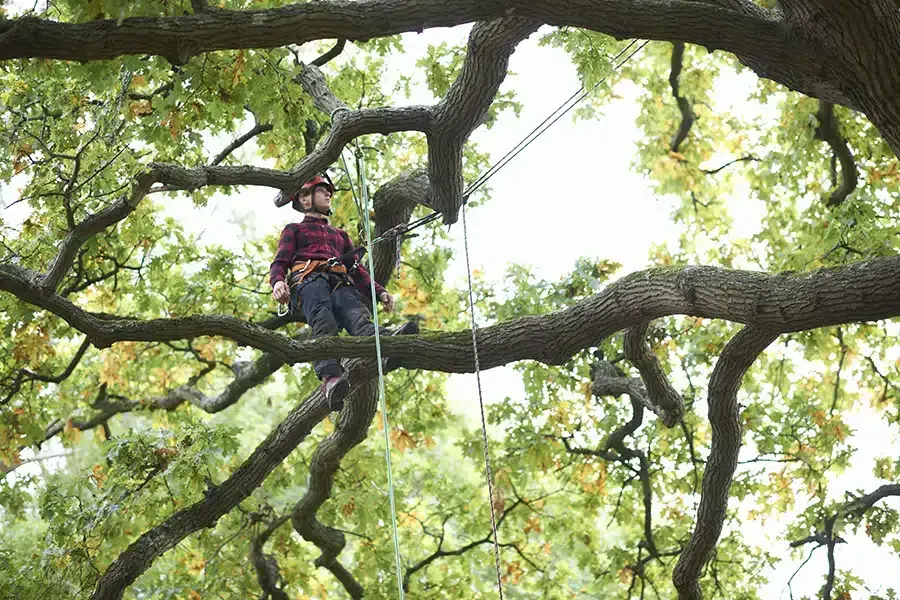Santa Clarita Tree Service
(661) 338-5661

Tree trimming is one of the most important aspects of landscape maintenance, but timing plays a crucial role in how effective it is. While spring and summer often get the most attention for outdoor work, fall is one of the best times to trim trees.
As the seasons change and trees begin their natural dormancy cycle, this transitional period provides several advantages for tree health, growth, and safety.
Whether you're preparing your property for winter or just trying to keep your trees in good shape year-round, trimming in the fall offers both short- and long-term benefits.
Here's why you should make
tree trimming part of your autumn to-do list.
Dormant Trees Are Easier to Trim
When trees enter dormancy in the fall, their growth slows down and their energy shifts away from new leaves and branches.
- No leaves improve visibility – Once the foliage has dropped, it’s easier to see the tree’s structure and identify dead or overgrown branches.
- Lower sap flow reduces stress – Trimming during dormancy minimizes sap loss and stress on the tree.
- Less risk of disease spread – Many tree diseases are less active in cooler weather, lowering the risk of infection from cuts.
Fall trimming sets the stage for healthy regrowth in the spring without interfering with the tree's active growing season.
Prepares Trees for Harsh Winter Weather
Tree trimming in the fall can help prevent cold-weather damage and protect your property.
- Removes weak or damaged limbs – Dead or compromised branches are more likely to snap under the weight of snow or ice.
- Reduces wind resistance – Thinning out dense areas of the canopy can lower the risk of the tree being uprooted during strong winter winds.
- Prevents limbs from damaging roofs or power lines – Clearing overhanging branches protects your home and avoids costly emergencies.
A well-pruned tree is more structurally sound and better equipped to handle winter storms.
Supports Healthy Spring Growth
Trimming in the fall helps trees bounce back stronger and healthier when spring arrives.
- Encourages balanced growth – Removing crowded or misdirected branches allows sunlight and air to reach more areas of the tree.
- Stimulates new growth in the right places – Pruning directs the tree’s energy to healthy limbs and promotes more vigorous spring growth.
- Improves flower and fruit production – For flowering or fruiting trees, trimming in fall often leads to better blooms and yields in the spring.
Proper fall trimming doesn’t just clean up the tree—it boosts its potential for the next growing season.
Minimizes Insect and Pest Problems
Fall pruning can help reduce the chances of pests invading your trees.
- Fewer insects are active – Many harmful insects and pests become dormant or die off in the fall, making open pruning wounds less vulnerable.
- Cuts discourage nesting or infestation – Removing decaying limbs can eliminate habitats for insects, rodents, or fungi.
- Promotes overall tree health – A healthier tree is naturally more resistant to pest problems year-round.
Timing your trimming during a low-insect season helps your trees stay protected and pest-free.
It’s More Convenient and Budget-Friendly
Fall is often a more practical and affordable time to schedule professional tree trimming.
- Easier scheduling with tree services – Arborists are often less booked in the fall compared to the busy spring and summer seasons.
- Less disruption to landscaping – With grass and plants going dormant too, there’s less risk of damaging flower beds or turf.
- Potential savings on seasonal discounts – Some companies offer fall promotions or off-season pricing for tree maintenance services.
Trimming in the fall can be more cost-effective and efficient than waiting until spring when demand peaks.
Tree trimming in the fall is more than just a seasonal chore—it’s a smart investment in your trees' health, your property’s safety, and your landscape’s overall appearance. By taking advantage of dormant growth, cooler temperatures, and fewer pest concerns, you can give your trees the best chance to thrive come springtime.
Whether you're trimming a few backyard trees or managing a larger landscape, fall is the ideal time to get the job done right.If you're not sure where to start or want professional help, a certified arborist can assess your trees and recommend the best approach. Don’t wait until winter hits—trim smart this fall and enjoy the benefits all year long.